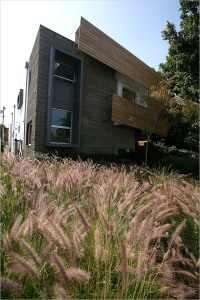Defining Green is an important first step towards understanding the conversation taking place surrounding the idea. When we first set to work writing the Green building standards for Minnesota we started by looking for a definition of Green building. Surprisingly very few people or organizations had sought to define it, so we did it ourselves. Here is what we came up with:
Green building is the application of the five key components to the traditional building practices for the purpose of improving the life of the occupant and the impact of the home on the occupant, the surrounding community, and the environment.
The five key concepts are as follows:
· Resource Efficiency (includes concepts of durability, embodied energy, Life Cycle Analysis)
· Water conservation (includes irrigation, plantings, indoor and outdoor water used)
· Energy Efficiency (Energy consumed in the operation and occupation of the home)
· Indoor Environmental Quality (Includes EMF, Radon, Lead, and air pollutants)
· Site and Community Impact (Erosion, storm water, land use, social impact, air pollutants outside the home, global community impact)
Since then, a number of people have also taken a pass at creating a definition of Green building and they all look rather similar to this one. The primary difference in definitions comes in the key concepts chosen. Some authors have taken a much narrower view eliminating the Site and Community Impact, or have chosen to deal with indoor air quality rather than indoor environmental quality. I do not buy into the stool or the chair metaphors (3 legs, 4 legs) but argue that there are five distinct sets of glasses that must be used to evaluate Green building. (Note: in theory we could move water into the resource efficiency category as water is a resource that we should be efficient with, however I don’t feel that it takes it far enough. It is not sufficient to be efficient with our water usage. Rather we must actively conserve our water resources and given waters close relationship with life it is deserving of its own category)
Which of these is the most important? I could make a strong case for Water, as we are rather dependant on it for survival, but in the eyes of Green building all five should be equal. In fact it is the balance that we strive to create between these five concepts that makes Green both viable and attractive to everyone. Green is the first win-win proposition to come around in a long while.
I would like to point out that we used the term “traditional building practices”. There are non-traditional building practices that can be very Green, however since the majority of construction in our world uses traditional techniques it seemed important to indicate that this was a shift in the way that we use those traditional methods. Keep in mind that “traditional” would include stick frame, masonry, concrete and steel, as well as cob, straw bale, stone, and earth (adobe and rammed). I look forward to the day when we can plant a seed and grow our bio-home, but until then we need to look to more accessible methods of construction.
It is also interesting to mention that under this platform of Green, we have seen numerous environmental groups come together along with generally conservative building associations and industry. Additionally, regulatory and government agencies have been willing to work with these groups in partnership; a change from the previously adversarial roles everyone had been used to playing.
